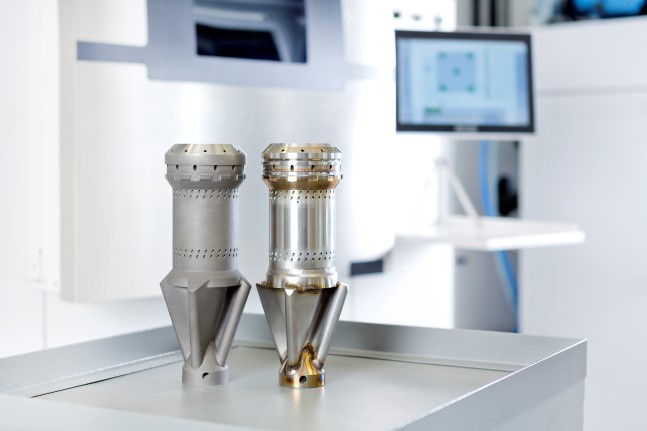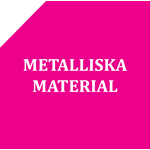Projektinitiativ #35: Tailored Materials for Additive Manufacturing ( 4 kommentarer)
Additive manufacturing (AM) brings a new paradigm in components manufacturing as the final properties are determined by combination of the initial chemistry, determined by utilized powder, and additive manufacturing process itself.
Lars Nyborg presents the initiative during the 2017 conference
At the current stage of the art, there is a significant lack of material development in AM as only about twelve alloys (twenty powders) are qualified for AM. Materials used for AM these days are traditional engineering alloys, typically used in powder metallurgy, that are optimized to fulfill AM requirements to the physical properties on the powder only, disregarding metallurgy of the AM process. Therefore, in order to exploit full potential of the novel microstructures, provided by AM, as well as to increase process window for AM manufacturing of a number of difficult-to-manufacture AM alloys, alloys has to be re-designed in order to take into account specific requirements of the additive manufacturing process. In addition , available powders for AM are characterized by high price (between 100 and 700 EUR/kg depending on alloy and manufacturer) due to the small-batch manufacturing by expensive methods as EIGA and VIGA. Therefore, to allow further growth of AM, accessibility of high-quality powder in high volumes at significantly lower price is required. This can be reached only by development of high-quality powder utilizing high-volume gas atomization methods, based on the recent advances in gas atomization utilizing knowhow by Swedish academia and industry. Therefore, this proposal focuses on tuning of the alloy composition utilizing thermodynamic and kinetic simulation tools to satisfy processing conditions during additive manufacturing as well as requirements by a specific AM technology (EBM, LS or LMD). Tailored powder alloys will be manufactured and characterized utilizing advanced surface and microscopy techniques and their processability tested utilizing laboratory and medium-size laser sintering machines at Chalmers.
Namn Eduard Hryha
Organisation Chalmers tekniska högskola
Kommentar #1
It could be of great interest of the Swedish PM-manufacturers and institutes to, in a longer perspective, have the powder specifications and the test methods for powder characteristcs of AM-powders standardised. Please consider the need of developing standards in parallell to the developing of test methods for powder characteristics and the powder specifications within this initiative. Sweden is holding and chairing the secretariat of ISO/TC 119 which is the proper channel for international PM-standardisation.
Namn Otto Björnberg
Organisation SIS. Swedish Standards Institute
Kommentar #2
Alloy development is IP for material and feedstock suppliers and it will be difficult to attract those companies to give detailed input and cooperation in such a project. If focus was on the basic understandings how to make a “fast track” to find out if a material is Go/NoGo and quickly find out the settings required for producing high quality AM parts it would not interfere with the interest of the material suppliers to keep and develop their own IP. Basic research and understandings on weldability – final part mechanical properties based on composition for AM produced parts could be a common interest that would not interfere with demand for keeping IP internal. Few alloys are in common use today and they are mostly copy of existing alloys from standard composition. How to make adjustments of the composition within the standard limitations are IP for the material and feedstock suppliers. Complement and develop modeling tools for alloy developing specific for AM would be much less a problem area for protecting IP. Regarding material standards for AM powders, the composition limits are normally set so wide that it is still the IP of the material and feed stock supplier how to adjust the composition within the standard limits to get optimum performance. This is my private opinion and may not reflect the official stand of the organization that I work for.
Namn Björn-Olof Bengtsson
Organisation Carpenter Powder Products AB
Kommentar #3
Intressant för Quintus.
Namn Stefan Sehlstedt
Organisation Quintus Technologies AB
Kommentar #4
Siemens Industrial Turbomachinery in Finspång, manufacturures, sells and services gas turbines for power generation and mechanical drive. Our products can be found worldwide. We have been working with Additive Manufacturing, SLM, since 2009. Today we have a fully equipped AM workshop with 24 lasers. Initially the goal was to repair burner tips in Hastelloy X, but today we manufacture several gas turbine components that can be found in operating engines. One problem is the lack of materials for AM. Only few alloy powders can be purchased, and they are not designed to take into account specific requirements for AM manufacturing. With more available alloys, that are designed for AM, we can increase the number of gas turbine parts manufactured by AM.
Namn Helena Oskarsson
Organisation Siemens Industrial Turbomachinery AB

